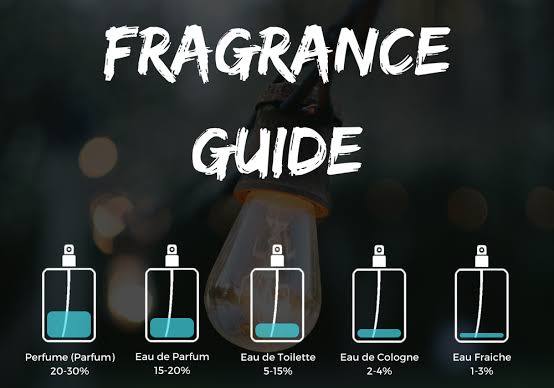Fragrances play a subtle but powerful role in how we present ourselves. Whether you’re heading to a date, a work meeting, or a casual hangout, the scent you choose can leave a lasting impression. But with so many labels like eau de parfum, eau de toilette, cologne, and more, it can be confusing to know what they all mean and which one suits your needs.

In this guide, we’ll help you understand the difference between eau de parfum and eau de toilette, along with the other major fragrance types so you can make smarter choices when shopping.
What Is a Fragrance?
The word fragrance comes from the idea of a “pleasant, sweet scent.” It’s a broad term that includes everything from mists and colognes to perfumes and aftershaves. Some people use the term scent more casually, referring to any smell—whether it’s perfume or even the scent of nature or pets.
Historically, perfumes were seen as products primarily for women, while men’s products were labeled colognes or aftershaves. But times have changed. Men can wear perfumes, and women can enjoy colognes. What matters more than the label is understanding what you’re buying.
1. Perfume (Parfum) – The Most Concentrated
Perfume, or parfum, contains the highest concentration of fragrance oils—usually over 20%. This makes it the longest-lasting option, often staying on your skin for 6 to 8 hours or more.
Key Points:
- Fragrance oil concentration: 20% or more
- Longevity: 6–8 hours
- Price: Highest
- Best for: All-day wear or special events
- Bonus: Lower alcohol content makes it ideal for sensitive skin.
2. Eau de Parfum (EDP) – Strong and Reliable
Now, let’s dive into the difference between eau de parfum and eau de toilette—starting with EDP. Eau de Parfum has a slightly lower concentration of fragrance oil, usually between 15% and 20%. It generally lasts 4 to 5 hours on the skin.
EDP is perfect for both day and night use and offers a solid balance of performance and price. It’s more affordable than parfum but still quite powerful.
Key Points:
- Fragrance oil concentration: 15%–20%
- Longevity: 4–5 hours
- Price: Moderate
- Best for: Versatile, all-day use
3. Eau de Toilette (EDT) – Light and Fresh
Understanding the difference between eau de parfum and eau de toilette becomes clearer when comparing EDT to EDP. Eau de Toilette has a fragrance oil concentration of 5% to 15%, making it lighter and more affordable.
EDTs usually last about 2 to 3 hours and are commonly worn during the day. In fact, the name comes from the French phrase “faire sa toilette”, meaning “to get ready.”
Key Points:
- Fragrance oil concentration: 5%–15%
- Longevity: 2–3 hours
- Price: Budget-friendly
- Best for: Casual, everyday wear
Main Difference Between Eau de Parfum and Eau de Toilette:
EDP lasts longer and has a richer scent, while EDT is lighter, more affordable, and better for daytime or warmer climates.
4. Eau de Cologne (EDC) – Mild and Refreshing
Eau de Cologne has an even lower concentration of fragrance oils—around 2% to 4%—and a high alcohol content. It’s typically cheaper and comes in larger bottles because it needs to be applied more generously.
EDCs are often fresh, citrusy, and ideal for a quick refresher.
Key Points:
- Fragrance oil concentration: 2%–4%
- Longevity: Up to 2 hours
- Price: Affordable
- Best for: Light use, summer wear
5. Eau Fraiche – Softest Scent
Eau Fraiche is the most diluted form of fragrance, with just 1% to 3% fragrance oils. Unlike EDC, it contains very little alcohol, making it suitable for sensitive skin. However, it only lasts about two hours and is mostly made of water.
Key Points:
- Fragrance oil concentration: 1%–3%
- Longevity: 1–2 hours
- Price: Low
- Best for: Sensitive skin, quick refresh
Fragrance Buying Tips
- Skin Type Matters: If you have dry or sensitive skin, opt for perfumes or eau fraiche with lower alcohol.
- Weather Counts: Heavier scents like EDP are great for cool weather, while EDT and EDC are ideal for hot days.
- Consider the Occasion: Use stronger scents for evening or formal events, and lighter ones for everyday wear.
Final Thoughts
Understanding the difference between eau de parfum and eau de toilette can help you pick the right scent for every occasion. Eau de Parfum is rich, long-lasting, and great for nights out or long workdays. Eau de Toilette, on the other hand, is light, refreshing, and perfect for daily wear.
Whether you’re choosing your next signature scent or simply trying to understand the labels better, this guide should help you make a confident decision.
FAQs
Q: Can men wear eau de parfum?
A: Absolutely! Fragrance is gender-neutral. Men can wear EDP just as confidently as women.
Q: Why is eau de parfum more expensive than eau de toilette?
A: EDP has a higher concentration of fragrance oils, making it more potent and long-lasting.
Q: Which is better for summer—EDP or EDT?
A: Eau de Toilette is better for warmer weather due to its lighter scent profile.
Q: How can I make EDT last longer?
A: Apply it on moisturized skin, especially pulse points like your neck, wrists, and behind the ears.
